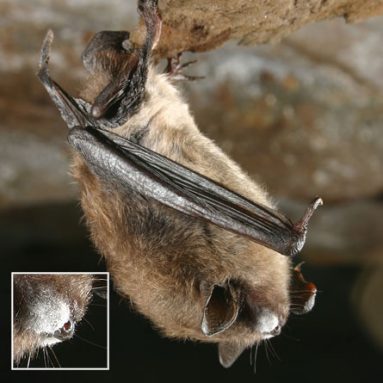White fuzzy mold not as friendly as it looks
New type of mold may be a bat killer
When you think of things that are white and fuzzy, usually you think of something cute or nice. But a newly discovered fuzzy, white mold may be making bats in the Northeast U.S. sick. The illness and mold strike during hibernation, bats’ long wintertime sleep.
The mold was first spotted by a cave explorer two years ago. The fuzzy fungus was growing on hibernating bats’ noses and wings. Bats with the mold often grew thin, weak and died. Scientists named this phenomenon “white-nose syndrome” after the mold found on the bats’ noses.
Since that first sighting, thousands of bats in the Northeast have died. Scientists now wonder if the mystery fungus may be the killer. Once the mold hits caves or mines where bats are hibernating, between 80 and 100 percent of the bats usually die, says Marianne Moore, a bat researcher at Boston University.

Scientists still aren’t sure if the white fuzz is the killer. The mold may just attack bats when they are already sick and more likely to get other illnesses. But, identifying the fungus may help scientists find out if it’s the killer.
To figure out what the fungus was, scientists studied it in a lab. They took samples of the mold from sick bats. Then the scientists brought the samples to a lab, where they could grow and be compared to other molds.
At room temperature, the scientists’ efforts were thwarted — samples of this mystery mold wouldn’t develop. Frustrated, the scientists finally tried putting the samples in the refrigerator. This cooled the samples down to temperatures found in bat caves during the winter. Sure enough, when the lab samples were chilly, an unfamiliar form of mold began to grow. The scientists think it may be an entirely new species, or type, of mold or a new form of an existing species.
What’s unusual about the new mold is that it won’t survive in higher temperatures, says David Blehert of the U.S. Geological Survey’s National Wildlife Health Center in Madison, Wisc. He and colleagues were part of the study that tried to grow and identify the mold in the lab.
Human noses, for example, are way too warm for the fungus.
In hibernation, “a bat for all practical purposes is almost dead” says Blehert. The heart of an active bat beats hundreds of times per minute. This can drop as low as about four beats per minute during hibernation. And a bat’s body during this time chills to only a few degrees above the cave’s temperature. The cold temperature of bat caves in New England makes for a perfect home for the mold.
This is good news for bats that fly to the warm south in the winter or live in warm, dry places year-round. Their caves will be too warm to host the white fuzz.
But the sickness has already hammered at least six species of bats in the Northeast. Two of these bats are the little brown bat and the endangered Indiana bat.







